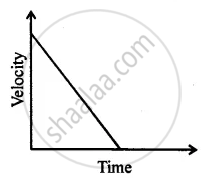Advertisements
Advertisements
Question
Multiple choice Question. Select the correct option.
The speed of a car reduces from 15 m/s to 5 m/s over a displacement of 10 m. The uniform acceleration of the car is :
Options
−10 m/s2
+10 m/s2
2 m/s2
0.5 m/s2
Solution
−10 m/s2
Explanation:
Initial velocity = u = 15 m/s
Final velocity = v = 5 m/s
Displacement = S = 10 m
Acceleration = a = ?
v2 – u2 = 2aS ;
(5)2 – (15)2 = 2a (10)
25 – 225 = 20a
a = −220/20 = -10 ms−2
APPEARS IN
RELATED QUESTIONS
When will you say a body is at non-uniform acceleration?
Fill in the following blank with a suitable word:
Acceleration is the rate of change of ______ It is measured in ______
Name the quantity which is measured by the area occupied under the velocity-time graph.
Explain why, the motion of a body which is moving with constant speed in a circular path is said to be accelerated.
State how the velocity-time graph can be used to find
The acceleration of a body
Derive the following equations for uniformly accelerated motion:
(i) v = u + at
(ii) `"S = ut" + 1/2 "at"^2`
(iii) v2 = u2 + 2aS
where the symbols have their usual meanings.
How can you find the following?
Velocity from acceleration – time graph.
Can you suggest a real-life example about the motion of a body from the following velocity – time graph?

A packet is dropped from a stationary helicopter, hovering at a height ‘h’ from ground level, reaches the ground in 12s. Calculate
- the value of h
- final velocity of packet on reaching the ground. (Take g = 9.8 ms−2)
Two stones are thrown vertically upwards simultaneously with their initial velocities u1 and u2 respectively. Prove that the heights reached by them would be in the ratio of `"u"_1^2 : "u"_2^2` (Assume upward acceleration is –g and downward acceleration to be +g)
